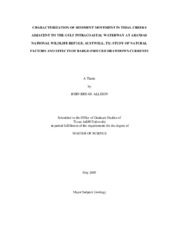| dc.description.abstract | The coastal wetlands at Aransas National Wildlife Refuge near Austwell, Texas,
support the last migrating population of whooping cranes during the winter months
(October through April). With a population currently at 216 individuals, these are the
rarest cranes in the world. The wetlands in which they winter are a part of the San
Antonio Bay system, a bay that receives constant fresh water flow from the Guadalupe
River. Currently there is a plan for using water diverted from the Guadalupe River just
before it enters San Antonio Bay as a water supply for the greater San Antonio
metropolitan area located 200 km to the northwest. The Guadalupe River delivers
nutrients and sediment into the estuary along with fresh water. Because of the
importance of sediment within a tidal wetland ecosystem, it is imperative to understand
the sediment budget and underlying forces that drive it if one is to ultimately grasp how
this ecosystem functions. To document natural and anthropogenic factors exerting
control over sediment movement in this system, three sites on tidal creeks near the
boundary between marsh and bay were chosen. The Gulf Intracoastal Waterwayparallels the marsh edge. Over six, non-consecutive weeks water level and velocity were
automatically monitored in the tidal creeks. Automated water samplers extracted water
samples that were analyzed for suspended sediment. In addition, bedload traps were
deployed in one creek to monitor sediment movement along the channel bottom. Inflow
exceeded outflow during the study. As a result there was a net influx of suspended
sediments into the marsh. Bedload material also moves with current direction, and it
appears to move in response to barge induced outflow currents. Barges passing on the
Gulf Intracoastal Waterway exert influence on water level, flow direction, and velocity
within tidal creeks. Natural factors such as winds, tides, and freshwater input from
upland runoff or river discharge also impact suspended and bedload sediments. | en |


